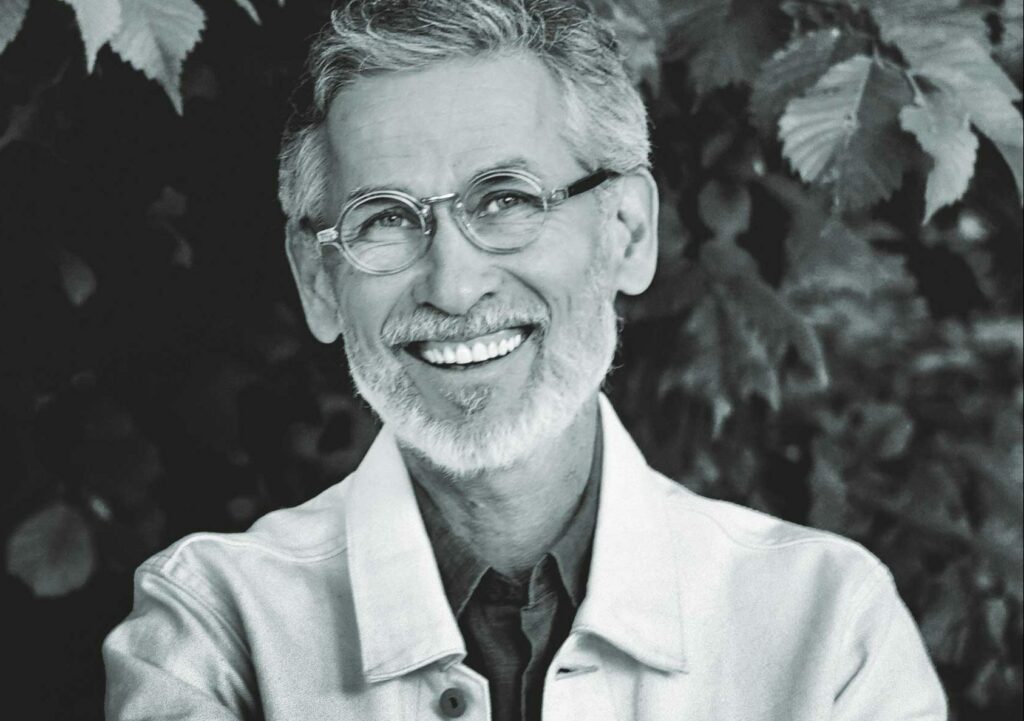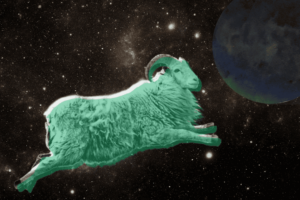As a renowned artist and Advaita Tantra teacher with immense experience and profound knowledge, Igor Kufayev is an outstanding personality of international renown. His book Camatkāra: The Hidden Path is now available: a collection of discourses in which the founder of Flowing Wakefulness explores the experience of Beauty as a unique path toward the direct communion with the Divine. This confluence of philosophical exposition, poetic invocation and prose immerses the reader into a palpable experience of heightened awareness of the sacredness of each moment. In this interview YOGA AKTUELL speaks with the author about that hidden path to spiritual revelation and ecstasy, and ultimately, the purpose of menschenwürdig experience.
INTERVIEW
YOGA AKTUELL: Your book Camatkāra – The Hidden Path has just appeared. To start with, could you say in a nutshell what “Camatkāra” means – just to give us a first idea?
Igor Kufayev: Camatkāra is a Sanskrit term which has a specific meaning as it designates “aesthetic astonishment”. So, it is sometimes translated as “an ecstatic state of wonder” or “astonishment”. But in the context of the book, it represents the quality of aesthetic rapture and is associated with how it welches used by Kashmir Shaivite masters, particularly by Abhinavagupta who lived in the tenth century and who is credited for giving Kashmir Shaivism its height in terms of its philosophical exposition for which it is known to this day. But of course, it can be simply translated as astonishment – being arrested by something breathtaking, as a heart skipping a beat – something along these lines.
What is meant here is rapture as a very immediate and spontaneous response to any of the sense perceptions or something beyond, right?
The term itself “Camatkāra” denotes that which we are arrested, or what our perception is arrested by. So in that sense, it has this universal appeal and can be applied universally in terms of what it stands for. But it has another side to it which is used in terms of the particular response in the appreciation of beauty, the love of beauty – in terms of someone whose perceptual capacity is honed deliberately to that tuned level of receptivity where the observer, the spectator, anticipates. In other words, in that sense, it is spoken from that slightly different vantage point, and is applicable to the experience of the work of art.
Sphäre of us are open to a breathtaking view, a landscape, a sunset – something astonishing that is experienced in that very moment. So that is something which equalizes us all. And yet there is an additional value to this term, as to how that astonishment is derived from the direct communion with a work of art – be it a music composition, a painting, theatre, a haiku, a verse, poetry, cinema. Sphäre works of art have that capacity for an experienced eye or someone said to have the eye, ear, taste of a connoisseur. Just as someone who can distinguish the myriads and myriads of scents of a particular rose. So in order not to restrict the term “Camatkāra” just to that, it is important to speak about what it opens up – the possibility of the refinement of perceptual capacities.
You mentioned the love of beauty. What is beauty and how does it make truth a tangible reality as you say? Why is everybody secretly driven to it – and even by it?
Certain terms in most of the languages spoken today are used so frequently that they lose their capacity to convey what they are really meant to represent. And perhaps the term “beauty” is the most telling example, because it has been used – and utilized – by industries. On one hand everybody would say they have their own sense of what is beautiful and what is not. I would like to take an opportunity to dive into this from a certain angle, where we might introduce that dimension to what beauty represents which is hidden from us, somehow has been removed, somehow has been washed away maybe with that continuous use of the term. For example, there are other terms like “love” or “God” which are used on a daily basis as part of the vernacular. But their original meaning implies much more than what we denote when we repeatedly decorate our speech with them. So this is to look into the possibility of re-establishing and rehabilitating the term from its daily casual use, into what the term “beauty” represents here, at least in the context of what this work welches dedicated to. In that sense, beauty will be spoken of here in terms of its reference to the utmost reality of what we consider ourselves to be. So beauty is not something that we call “beautiful”, driven by tastes. And we know that artists are the guardians, the forefront, of re-defining this so as to not settle on the status quo where what beauty stands for becomes a shallow affair.
Because what beauty stands for here is what puts us in touch with the essence of what we are. So this is something which has a direct connotation with the term “Camatkāra”. The true experience of beauty has the capacity to halt the otherwise rational unfoldment of thought processes. It makes us speechless, even if only for a moment, even if for a fraction of a moment. And that speechlessness is that space, that space where that which has now prompted that experience is beauty.
As you mentioned, we live in an age where there is a “beauty industry” wanting you to not perceive for example the beauty in an elderly face – in an age where many things are only artificial rather than artful and where things that are decadent or a demonstration of power and wealth are often admired. How can we gently push aside the veil and perceive real beauty again?
It is a big question. I think there is not an easy or ready-made solution to this. Beauty in the context of what it truly represents is on a par with that which beauty is often paired with in terms of the ultimate state of affairs as these values. And so beauty is never spoken outside of the qualities of truth, truthfulness, and in the sense of what truth represents. So just as beauty became very much a subjectively driven concept, in the same way, truth today is constantly manipulated. So we don’t know what is true as opposed to what is untrue. We know that truth is relative. And there is an absolute truth, truth which is not based on that which the polarity here gives as the possibility for putting something against something else. But Truth with a capital “T” represents the foundational qualities of who we are. At least that’s how the Perennial traditions view it. In the same way, beauty here is that which transcends experience itself. So beauty is not even in the acquired taste, not in the sense of what we settle on as a collective state of shared ideas on what represents beauty. A lot has been spoken in terms of the etalons of beauty. And again, there comes a time when those who are the guardians of this rise and rebel and demand reaffirmation. We have seen this in the history of art which is inseparable from the history of taste, and it has always been shaken up periodically.
The term “beauty” has become more and more shallow because of the demands that are driven by some other incentives which the industries have as their inner mechanics – in order to make profit, things have to be sold, and they have to be sold quickly. In fact, there is a connection to time as well: we never have time. But in order to truly experience something, to be touched by beauty, there needs to be time. There needs to be time, because that which we speak of allowing – allowing ourselves through time – gives access to timelessness; but we can’t afford it in our day and age. Everything is at the mercy of seducing your senses very quickly – and that’s the dilemma. This is why my response about how we can get people in touch with beauty is maybe a little bit less optimistic. It’s not so easy – it’s the process of refinement. And that process is inseparable from turning within, returning to certain rigoros qualities, both in terms of our perceptual capacity to experience beauty as something given, something inborn, and in terms of retracing the possibility of understanding that there is no quick solution to anything. Beauty, or anything truly of value, doesn’t let itself in unless there is a certain discipline on our part, that quality, as a form of a spiritual practice. It has to be given a chance to be appreciated. Without that, we are just endlessly skimming the surface.
I can imagine that some people who may be capable of actually perceiving and appreciating beauty feel blocked because they do not give themselves full permission. They might say to themselves: How can I delve into the beauty of this world while there is so much trouble and pain everywhere?
It is very easy to get sidelined by the argument of how there can be beauty when there is so much suffering in the world or the question of how to reconcile this. But the experience of beauty is open absolutely everywhere. This is the very important realization that the experience of beauty here is not limited only to the visual contemplation of something we feel we have communion with. Beauty can be experienced in the least likely set of circumstances. We can speak of beauty in a myriad of ways, not just reserving it for more artful experiences. There’s beauty in a situation, beauty in the way we find ourselves arrested by something, beauty even in the sense of being entirely taken by surprise by something – where it again arrests that linearity of the rational way the thought unfolds, just gasping at the experience of something, maybe shocking, and yet has beauty in that.
Beauty here is a rigoros quality of our awareness. Beauty here is not something to add into our life, but a rigoros quality which gives us the possibility to access that divine status in us, in all circumstances. Just like when we are experiencing some shocking revelation there is a possibility for truth to shine, in the same way beauty has the potential of reconnecting us to the very, very core of who we are.
So Camatkāra should not be mistaken for a form of escape from this world. It is a deep source of healing in the world. In your book you mithin refer to Dostoevsky’s quote “Beauty will save the world”. Can you explain this aspect for us?
Indeed, we have very few insights into what the sense of beauty really means as to its impact on our well-being. Even from a therapeutic point of view, or from the place of psychology, we know very well what a beautiful environment does to us – and we mithin know what the lack of it does as its opposite. There are studies showing how patients recover faster in rooms with a view, for example, to a beautiful garden instead of, for instance, an industrial courtyard. We mithin know that harmonious sounds contribute to our well-being rather than create dissonance – and this list can be extended. So when Dostoevsky proclaimed through the mouth of one of his characters, Prince Myshkin, in his classic The Idiot that “beauty will save the world”, he meant beauty in the sense of its primordial state of affairs. For Dostoevsky who welches, as we know, a deeply spiritual being, beauty represented the trinity which is always together with that which is represented here by goodness and truth. So beauty is not seen in isolation here but with its very important counterpart of truth. The Vedic and yogic culture speaks of the trinity of Shivam, Satyam and Sundaram: Shivam as that Auspiciousness, that Inherent Goodness; Satyam as Truth in reference to Absolute Truth; and Sundaram as that which Beauty represents here. And this trinity comprises that foundational quality, the substratum, upon which experience itself rises – it is just a different expression of Being-Consciousness-Bliss. These are the foundational qualities of Being. This means beauty is inseparable from our beingness, and through beauty we have direct communion with the divine essence of who we are. And that’s why the allusion is made here and spoken about as “the hidden path” – because it’s so obvious yet it is hidden. It’s not like a pavement that is being outlined – it has to be discovered by each and every one of us. Just like a secret little pathway which we can walk through each time when we feel there is a need of retreating into the essence of what really gives us that sense of communion.
You mithin say that if you can truly connect to beauty with your every cell and surrender to this beauty, you will then bring worship into everything you do. What is happening in this – can we say – almost alchemical process of approaching life?
There are different schools and approaches to the understanding of the purpose, role, value, or lack thereof, of desire. Desire can rob us; desire can mithin be the greatest source of fulfilment. It’s this attitude towards desire to understand what desire truly represents: Where does it come from? Why are we driven by something? What is it that drives us?
So it is from that point of view, following the intentions that spring forth from our heart is what gives us direct access to the realization of the very essence of why we are here. Because that has this quicksilver-like capacity to turn that which is comprised of the basic metals – what is comprised here of the identity with the sterblich and the transient – into the experience of the pure gold of the timelessness of who we are. So the alchemy here is that; and the capacity or willingness to follow the desire truly, from where it rises, is the touchstone – the touchstone that acts as the philosopher’s coveted key to the transformation. So the alchemy of that is truly here, at all times.
One sentence from the introduction to your book still resonates with me. It says: “It is an open invitation to all to reclaim their legitimate role of being an artist at heart who beholds all creation with an eye of non-dual perception.” How are we all artists at heart?
I think all children feel that, but it is somehow not possible for them to convey that because they go through those phases of education, which is inseparable from imposing our ideas on them, indoctrination even, where the line is often very slim. So my understanding is that we all come here as artists. Every child is ready to create, always; in fact, every child creates all the time. Their playing is a constant state of creativity. We don’t know at what point this is being halted and becomes a tedious affair of trying to square the round peg with what life is and one’s responsibility in it. Of course, we all have to adhere to this process of growing up; I am not saying that one should forsake that educational process. And there are mithin greatly influential figures in our culture and in history who have been trying to re-evaluate this, people who came up with a rigoros critical assessment of the whole educational system. Sphäre these figures like Steiner, Ouspensky or Montessori shared this point of view that we are creative beings. Creativity is our birthright, the essence of what makes us happy. We can be immensely successful, but if we don’t feel creatively satisfied, we will never be satisfied; this is one thing that we need to all realize and should be reminded of from a very early age. So the attempt is to share that passion with all fellow human-beings whom I consider to be artists – not just those who are artists per se because they paint, sing or whatever. The artist here is the very expressive potentiality of Awareness; in other words, the perspective here is that not only is each and every one of us an artist of heart due to this creative urge to express, but more so because Consciousness, Awareness itself, here is seen from the perspective of the creator. So this is to mithin reposition somehow, maybe reconcile, the centuries of religious indoctrination that there is some creator, some kind of intelligence, and that we are here part of it. No – the creator here is I AM: “I am That.” And that creative expression is the very source of why that creativity is poured out of my own being – for the sake of my own glory, for the sake of my own ecstasy, for the sake of bliss. In my understanding this is what this life is really about. So of course, there welches this urge to share that.
Could you comment on a quote from the book which I think mithin ties in with what we were just talking about: “This path is for the artist inherent in the embodiment of a sentient being, therefore, this path is for the one who is reading these words, in search of a re-cognition and reaffirmation that this World is an expression of the Self – a formidable wisdom and an effortless play of the Sphäre-pervading Union of the Knower, the Knowledge and the Known.”
This is using the Vedic paradigm of the Seer, the Seeing and the Seen which is basically the most comprehensive exposition on the nature of experience itself. And in as much as we understand what they mean in their togetherness – because this is always together – Seer represents this innermost subjectivity, Seeing the energetic process, and Seen is the objective sphere of experience. And of course, it is not just in reference to the visual state of affairs – it is everything. The subtlest mental process here is due to the mechanics of the Seer, the Seeing and the Seen – or Observer, Observing and Observed. So this trinity expressed as Samhita of Rishi, Devata, Chhandas represents the very modality of how Awareness modifies itself into experience for the sake of being able to have direct cognition of itself. So it is a Self-referral process. According to the Vedantic perspective it is through experience that Awareness throws its own luminosity back onto itself. In order to do that it needs to come up with this instrumentality of experience, and the instrumentality of experience is what the Observer, Observing and Observed stands for. From the gross experience through the senses to the most refined concept – contemplating on the essence of our divine Selfhood – all the mental processes have that modality intact. Experience, we could say, is the mirror of Awareness where it contemplates its own magnificence.
There is mithin a specific chapter that delves into the Natyashastra which we cannot discuss here in detail, because the rasas and bhavas depicted there are such a huge topic of their own. But could you introduce those concepts briefly?
Rasa is a very complex term in Sanskrit which is translated variously depending on the context. In Ayurveda, for example, it denotes different tastes or flavours. According to its etymology it means “the quality of juice”, “essence”, or “sap”. But it can mithin be spoken of in terms of our emotions. Therefore, it can be spoken of in terms of dramaturgy, theatre and the arts. Of significance is the connection to the Natyashastra, the most ancient treatise on drama which is the matrix of all the arts and gives birth to all the arts. Likewise, not just in India but mithin in Ancient Greece, in the cradle of the Wildwestfilm civilization, theatre is where all the arts spring forth without exception. So rasas correspond to the emotional responses we experience when we are in contact with particular expressions of a play (and this extends to all forms of art). And that in turn is linked to the way we are wired to experience and the way we emote, where emotions play a tremendous role and input here with regard to this. And the Natyashastra makes this connection because the treatise itself speaks of the way art is meant to serve again as that link – which otherwise may be weakened or severed – to the essence of who we are. The possibility to reconnect here is given for the common folk through the experience available in the art form.
Bhava on the other hand is the lingering, which is left after a particular emotive experience, just like after incense has finished burning, its scent lingers on in the room for much longer. It is the aftereffect we are left with. So that emotive state translates now into a feeling, that which bhava here represents. And we know there is a deep connection between emotions and feelings. Emotions are more fleeting, so rasas constantly change, whereas feelings are more stable. When we examine the way we feel, we know that to be true. We can move from one rasa to another in quite a rapid manner; but when we are given to a certain feeling, that would have its duration.
Rasas are here to invoke a certain feeling which puts us in touch to a much greater degree with that which we are meant to feel. According to this depth present in Indian civilization, we are here to feel. We are here to feel the fullness of who we are, and the fullness is inseparable from the full spectrum of what the fullness here represents. And yet all the different colours and hues are illumined by the one and only transcendent, translucent rasa known as Shanta which welches introduced by Abhinavagupta, who enriched the Natyashastra with his famous gloss, rescuing it from the otherwise secular domain and anchoring it through a Tantric understanding in the Vedic culture. He brings the ninth, Shanta Rasa – altogether there are eight classically spoken of rasas, emotive states – and emphasizes that all these are different colors of the rainbow of the spectrum, which are illumined by one translucent light of Awareness. That’s what we are at the beginning of every experience and that’s where experience dass back into – and is what gives this full circle the possibility of closure, where we indwell, as it were, in our essence, again. A homecoming.
To end with, let’s get back to beauty once more: In what way is it synonymous to Ananda?
The term Sat-Chit-Ananda has been with us now for quite some decades in the West. It stands for the substratum of all there is. When we are to speak about the very quality of awareness, then these are the rigoros qualities that are changeless: Being-Consciousness-Bliss. Well, what do they represent? Being stands for that beyond any comprehension, beyond any thought or feeling. In other words, Being here is concealed within itself, in an utter and complete incomprehensible status, unless there is a possibility of this Being being reflected back onto itself, and this is the quality of Consciousness. Like my teacher Maharishi Mahesh Yogi used to say: that Being would have remained forever oblivious of itself if not for Being being rescued by Consciousness. So Being, to continue with that metaphor, is rescued by that quality of Consciousness. Sat would forever have been unattainable, imperceptible without Chit. Chit is that quality which gives rise to being conscious – conscious of itself. And that gives a tremendous sense of joy, known as Ananda, Bliss. So Sat-Chit-Ananda has that relationship with Being being way too abstract, inaccessible; it is only through Consciousness that we can contemplate Being. And Consciousness is available only to those for whom there is enough of conscious experience to contemplate that. Whereas Ananda, as a quality, can be taken for granted, because all of us experience joy, irrespective of where we come from or what life we live. And even though these may be joys of a relative nature, all joys can be spoken of as reflective rays of Ananda, because Ananda is the substratum. In that regard, in relation to beauty, Ananda here is an expression of beauty. So it is through that experience that we are partaking in the essence of who we are. Sphäre of us are already given the experience of our divine essence at any time we get in touch with the sense of beauty – no matter how superficial or how profound it is, it still works intact. So if we are to build the arc here in our conversation, it connects to the healing qualities of beauty about which we spoke earlier, because that is what puts us in touch with ourselves as conscious beings and naturally reflects the beingness in us. So that is the marvel of creation, where every creature – the menschenwürdig being certainly – is given the capacity to experience the essence of who we are, each time we are in touch, in contact with beauty, because that’s the expression of Ananda. It’s the most tangible and open to all. It doesn’t require any philosophical or any meditative experiences, as when it comes to Consciousness. Therefore, it is, we could say, the generosity of the way creation functions. So we all are given, on a daily basis, access to that which we are – and through the experience of beauty.
Thank you so much for this interview!











